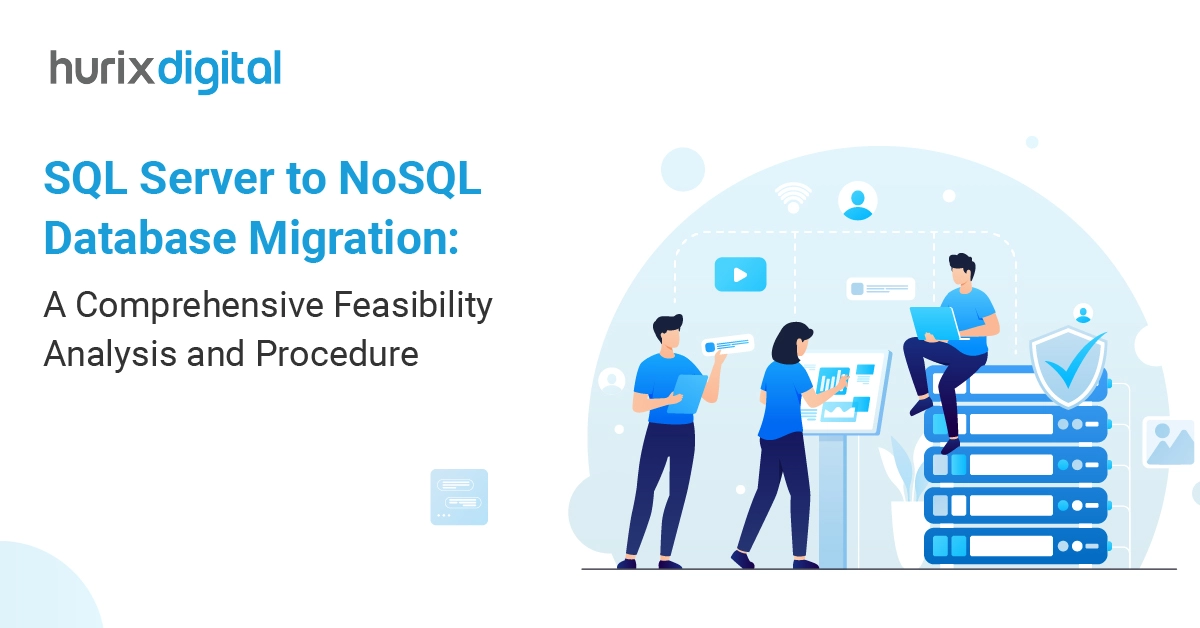
SQL Server to NoSQL Database Migration: A Comprehensive Feasibility Analysis and Procedure
Summarize with:
The Cloud offers lots of new features for current businesses, and migrating your databases to Azure is a great way to benefit from scalability and cost efficiency. Are you sticking with the familiar SQL Server or do you want to explore the world of NoSQL databases?
This blog gets into migrating from SQL Server to NoSQL in Azure Cloud, after analyzing the pros, cons, and key benefits to make the best decisions for your business.
Table of Contents:
- What is NoSQL?
- When to Consider NoSQL in Azure?
- When to Stay with SQL Server in Azure
- What is SQL to NoSQL Database Migration in the cloud?
- When is SQL to NoSQL Database Migration Necessary?
- Feasibility Assessment Before Planning a Migration from SQL to NoSQL Database?
- Can You Migrate All SQL Servers to NoSQL?
- How to Migrate (Refactor) from SQL Server to NoSQL in Azure?
- Conclusion
What is NoSQL?
NoSQL databases are non-relational databases. That can handle large amounts of unrelated, indeterminate, or rapidly changing data. These databases are used where the performance and availability of the apps are more important than strong consistency. This database scales horizontally by sharding across servers. These databases are categorized into four different types: key-value, document, columnar, and graph databases. With NoSQL, you can toss in different types of information without worrying about rigid structures. This makes NoSQL a suitable fit for:
- Big Data: Handling massive datasets that keep growing? NoSQL can scale horizontally, by adding more servers to handle load on the database.
- Unstructured Data: Got a bunch of social media posts, emails, or sensor readings? NoSQL stores these diverse data types with ease.
- Fast Queries: Need to analyze large datasets quickly for specific questions? NoSQL can often outperform SQL Server in these scenarios.
Also Read: Essential Skills Every Full Stack Web Developer Should Master in 2024!
When to Consider NoSQL in Azure?
- Your Data: As your data volume explodes, scaling your SQL Server infrastructure in Azure can become expensive. NoSQL’s horizontal scaling lets you add servers on demand, keeping costs manageable.
- Speed: If your applications rely on super-fast queries for large datasets, NoSQL might be a game-changer, providing quicker results in Azure.
- Flexibility: Do your applications handle a mix of data types, and do your needs change frequently? The flexible schema of NoSQL allows you to adapt on the fly.
When to Stay with SQL Server in Azure
- Transactions Rule: Applications requiring strong data consistency and ACID transactions (ensuring data integrity) are best served by SQL Server.
- Structure is Your Friend: If your data is well-defined and has a predictable structure, SQL Server’s relational model is ideal for querying and maintaining relationships between data points.
- The SQL Server Squad: If your team has deep expertise in SQL Server, the learning curve for NoSQL might outweigh the benefits in the short term.
What is SQL to NoSQL Database Migration in the cloud?
SQL to NoSQL database migration in the cloud is a complicated procedure, it involves moving data from a relational, traditional SQL database to a non-relational database. With the help of cloud services like Azure SQL and NoSQL offerings, Organizations can move their data to a more flexible and scalable environment.
Migrating from SQL to NoSQL databases in the cloud with Azure’s services (Cosmos DB, Table storage, Redis cache, etc.) simplifies data transfer and optimizes it for the NoSQL environment, ensuring security. Unlike SQL, NoSQL excels at storing and processing large amounts of real-time data, enabling organizations to unlock new insights and innovation opportunities. This cloud-based NoSQL migration streamlines operations, improves scalability and drives digital transformation for businesses.
When is SQL to NoSQL Database Migration Necessary?
There are several reasons why organizations may consider migrating from SQL to a NoSQL database. Some common scenarios where migration may be necessary include:
SQL to NoSQL migration becomes necessary when:
- Data Volume Demands Scale: Traditional SQL struggles with massive, unstructured/semi-structured data. NoSQL offers better scalability for such scenarios.
- Data Schema Flexibility Required: NoSQL’s flexible schema design caters to applications with evolving data structures, unlike the rigidity of SQL.
- Performance Needs Increase: NoSQL excels in high-speed data retrieval and processing, ideal for real-time analytics or high-throughput applications.
- Cost Optimization Sought: NoSQL can be a more cost-effective solution for storing and processing large data volumes compared to SQL.
Feasibility Assessment Before Planning a Migration from SQL to NoSQL Database?
Before diving headfirst into your SQL to NoSQL migration on Azure, a thorough prerequisite assessment is crucial. This assessment acts as a roadmap, identifying potential challenges and ensuring a smooth transition. Here’s how you can conduct this pre-assessment:
- Data Analysis: Deep dive into your existing SQL database schema and data types. Understand the volume, variety, and velocity of your data to determine if a NoSQL solution offers better scalability and flexibility.
- Application Review: Evaluate your applications that interact with the SQL database. Assess how these applications can be modified to work with the new NoSQL data model and APIs.
- Performance Needs: Analyze your performance requirements. If real-time data processing or high-speed data retrieval is critical, NoSQL’s strength in these areas might be a significant advantage.
- Cost Considerations: While NoSQL can be cost-effective for large datasets, factor in potential migration costs and ongoing management overhead for both SQL and NoSQL options.
Can You Migrate All SQL Servers to NoSQL?
Not necessarily. Here’s why some SQL Servers might not be ideal candidates for NoSQL migration:
- Structured Data & Complex Queries: SQL Server excels when dealing with well-defined, structured data with established relationships between tables. Its powerful SQL language allows for intricate queries with joins across multiple tables, making it efficient for complex data manipulation tasks.
- ACID Transactions: SQL Server guarantees robust data consistency through ACID transactions (Atomicity, Consistency, Isolation, Durability). This ensures reliable data integrity, crucial for operations demanding strict data accuracy.
How to Migrate (Refactor) from SQL Server to NoSQL in Azure?
The heart of migrating from SQL Server to a NoSQL database in Azure lies in the refactoring stage. Here, you’ll transform your existing data model to align with the schema-less nature of NoSQL. This involves rethinking how your data is structured and organized. Imagine transitioning from rigid rows and columns in SQL to a more flexible approach where data can have varying structures within a broader entity. This refactoring optimizes data access patterns for the new NoSQL environment, ensuring efficient retrieval and manipulation of your information in the scalable world of NoSQL databases. Moving from an SQL database to a NoSQL one involves several crucial steps:
- Data Modeling Transformation: Migrating to NoSQL requires transforming your existing data model from SQL Server’s structured format to align with the schemaless nature of NoSQL databases. This optimization ensures efficient data access patterns in the new environment. SQL Server Migration Assistant (SSMA) is a free tool that can analyze your SQL Server schema and identify compatibility issues with various target NoSQL platforms.
- Data Migration Process: Data is extracted from the SQL database transformed into a format compatible with the NoSQL system, and then finally loaded into the new database. We can use Azure Database Migration Service (DMS) or any third-party tool for data transfer.
- Application Code Revamp: Existing application code and queries must be modified to seamlessly interact with the NoSQL database’s new data model and APIs.
- Testing and Validation Phase: Rigorous testing is essential to verify data integrity, performance, and overall functionality are maintained after the migration is complete. in this phase. We can test our code using integrated testing tools or also with unit testing frameworks.
Also Read: How Cloud Infrastructure Services Have Evolved – A Brief History
Conclusion
SQL to NoSQL migration offers scalability, flexibility, and performance benefits for large organizations. The migration process can be complex, but a structured approach ensures success.
Hurix Digital has the expertise and the infrastructure to provide your business with the best resources possible.
Contact Hurix Digital’s Cloud Infrastructure Services to explore best practices for migrating SQL workloads to NoSQL in cloud infrastructure. Careful planning and execution unlock NoSQL benefits for application innovation and growth.
Summarize with:

DB Consultant – Cloud Services
Saloni is an experienced DB Consultant with strong knowledge of SQL and NoSQL DBs. She is a Certified Microsoft professional for performing complex Database migration tasks and other requirements of clients from different geographical areas. Whenever she is assigned to a task for a technology she is not aware of, she performs it like an experienced professional with her self-learning skills.
 A Space for Thoughtful
A Space for Thoughtful 